Newly breeding colonisers from the Continent might have become regular this century, but it still came as something of a surprise when it was announced that six pairs of Eurasian Spoonbill had bred and fledged 10 young at Holkham, Norfolk, in 2010. Counts from 2018's breeding season showed that the colony supported 28 pairs and has produced a total of 244 youngsters. The species' breeding record at other sites in Britain remains as intermittent and minimal as ever, though.
The first prospective pair built a nest at Cley, Norfolk, in 1989, after which the Rare Breeding Birds Panel said that "colonisation of Britain is, perhaps, a realistic possibility". Consistent breeding didn't happen straightaway, but invasions in 1996, 1997 and 2005, with mating behaviour occurring every year at a number of sites, kept anticipation high.
The species seems to be extra sensitive at breeding sites and continually failed to get beyond the nest-building or egg-laying stages, with eggs being predated by Foxes and Grey Herons and – more ignominiously – also thwarted by nest-dismantling Eurasian Coots. However, the first fully fledged juveniles were noted in 2008 in Dumfries and Galloway.
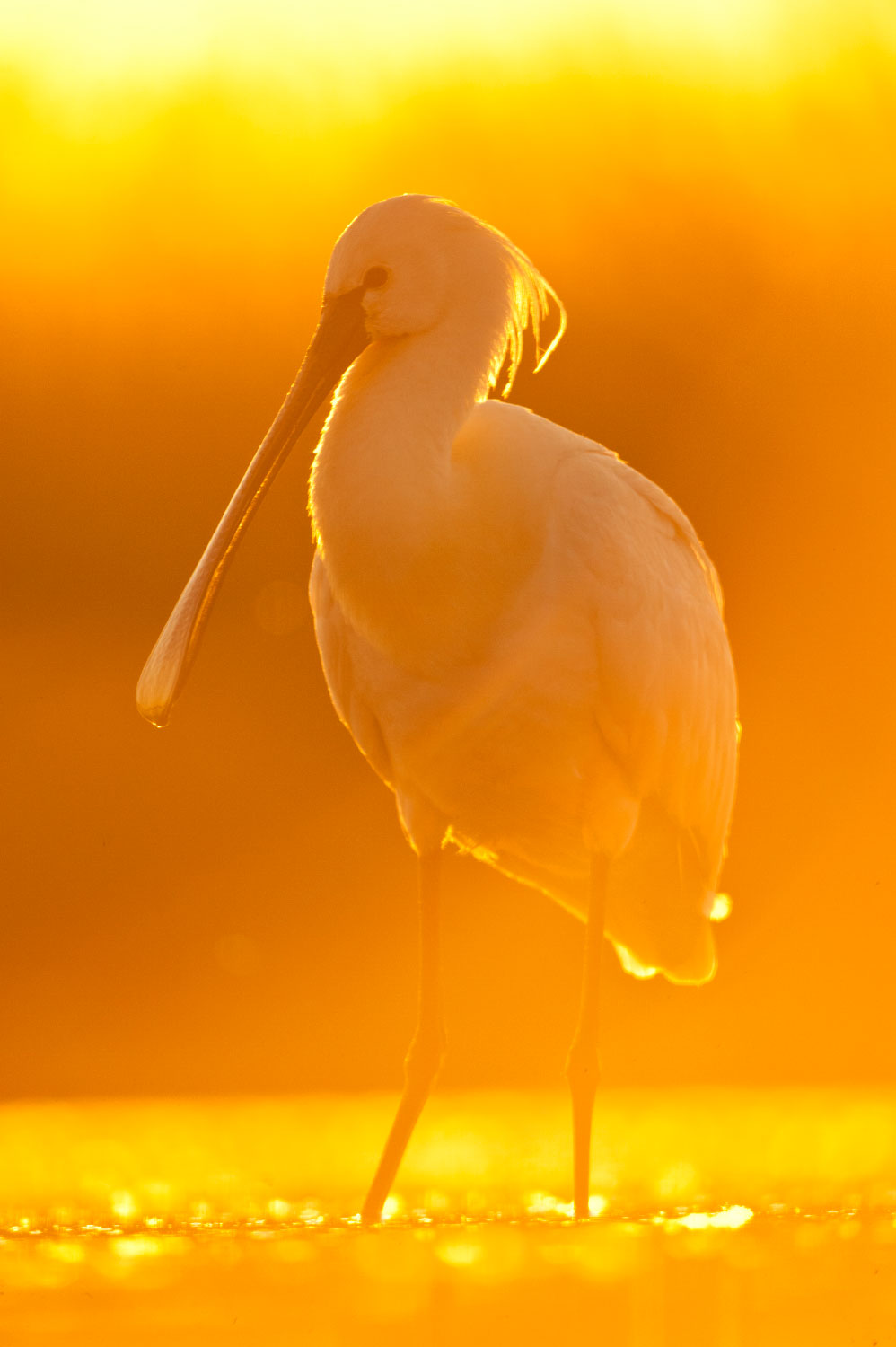
Eurasian Spoonbill may be an exotic-looking species more familiar on Mediterranean wetlands, but it was historically part of Britain's avifauna and seems to be staging a comeback (Bence Máté / www.agami.nl).
Back to Britain
Despite the bird's exotic appearance, though, this ultimate breeding success was, in fact, a return to form after a gap of about 350 years – the recolonisation of a species so well known in medieval times that it featured in royal banquets and was widely viewed as a gamebird. A colony by the River Thames at Fulham was recorded in 1523 and the species' breeding range extended across southern England and Wales at least, until hunting and drainage put paid to it. The species remained part of The Netherlands' breeding avifauna throughout and it is from this stock that our colonists are believed to be derived.
While Eurasian Spoonbill has yet to join Little Egret at most wetland sites as an expected part of a day's birding, it is among the notable establishment of several other warmer-climate waterbird species, including Great and Western Cattle Egrets and Little Bittern. The Norfolk spoonbills are in a mixed colony of Little Egrets, Great Cormorants and Grey Herons, slotting right in as it might do anywhere on the Continent.
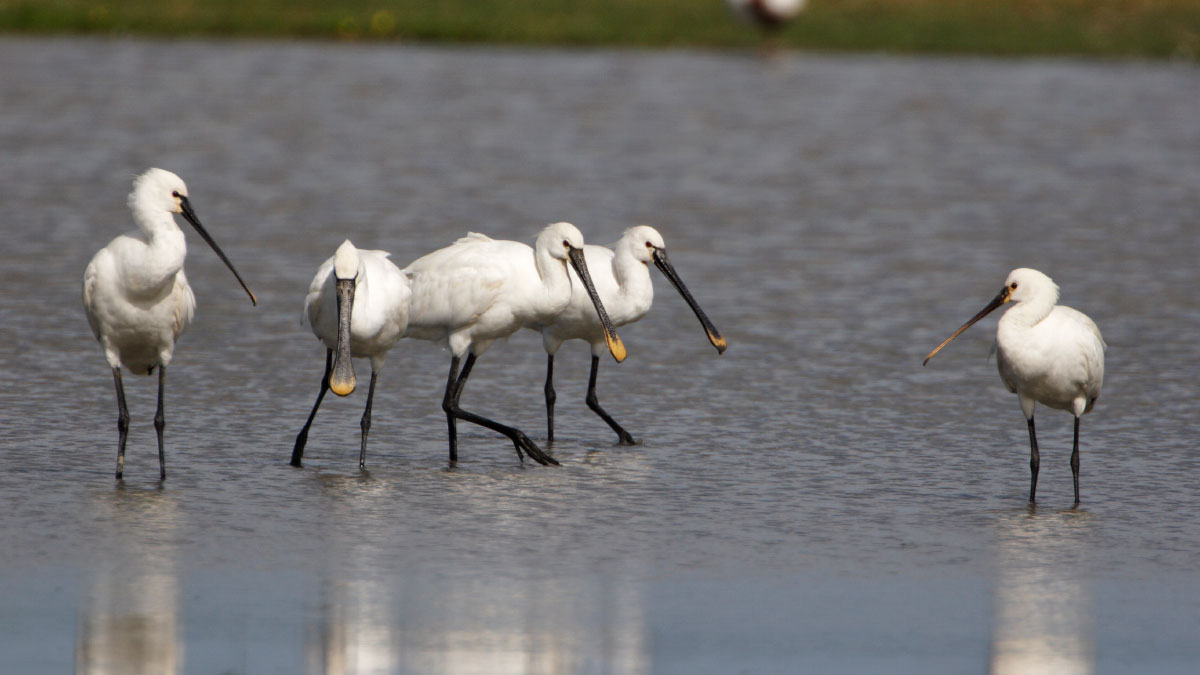
Populations in Norfolk are going from strength to strength and Eurasian Spoonbill is now a regular sight in the county (Robin Chittenden).
In a British and European context, Eurasian Spoonbill is unique and distinctive due to the ladle-like structure of its bill. This marvel of hard-tissue and soft-tissue evolutionary engineering is at the root of one of its old folk names, 'banjo bill', and separates the spoonbills into their own genus – they are otherwise ibises, physiologically, and belong to the same family.
Eurasian Spoonbill feeds by wading purposefully in shallow water, waving its bill from side to side, often in a slanting-line formation, somewhat reminiscent of Avocet. Foraging parties can be active by night and day, when not roosting in trees or on one leg on sheltered shorelines. Its diet consists of small water invertebrates, mainly water beetles, but also insect larvae, small fish, water snails, crustaceans, tadpoles, worms, leeches and even the odd bit of algae. Spoonbills time their summer return to the Dutch polders to match that of Three-spined Sticklebacks from the sea to the area's ditches and pools, and this is one of their major food items in early spring.
Extraordinary evolution
Such hoover-like feeding efficiency relies on the species' extraordinary beak and a number of supporting adaptations. Recent work on the bill of Eurasian Spoonbill's close relative Black-faced Spoonbill has revealed intimate details of the structure of this ergonomic tool. On a lateral view, the bill is not unlike the long, curved shape of its ibis relatives, with a downcurved tip. However, from above its spatulate shape – with a thin base and a broadened, flared tip – is immediately apparent.
The bill is very flat to minimise drag in turbid water, while the mandibles are smooth edged without the sharp 'teeth' or cutting edges often found in fish-eating birds. The edges are curved inwards and have tiny thin ridges at the tip and many tiny tubercles towards the face, which develop during the bird's first winter and apparently allow it to grip a variety of prey items. Unsurprisingly, perhaps, with such a complex gadget attached to its head, Eurasian Spoonbill is relatively silent, with just a few grunts among its adult vocal repertoire.
The bill has many sensory cells which enable very tactile feeding in muddy water where eyesight is next to useless. It is swept back and forth from side to side, with the odd bout of pecking – spoonbills do not grub about in the sediments but instead select food items from the swirling water created by their movements. The bill also has a wide gape, allowing the swallowing of larger prey items such as fish and frogs.
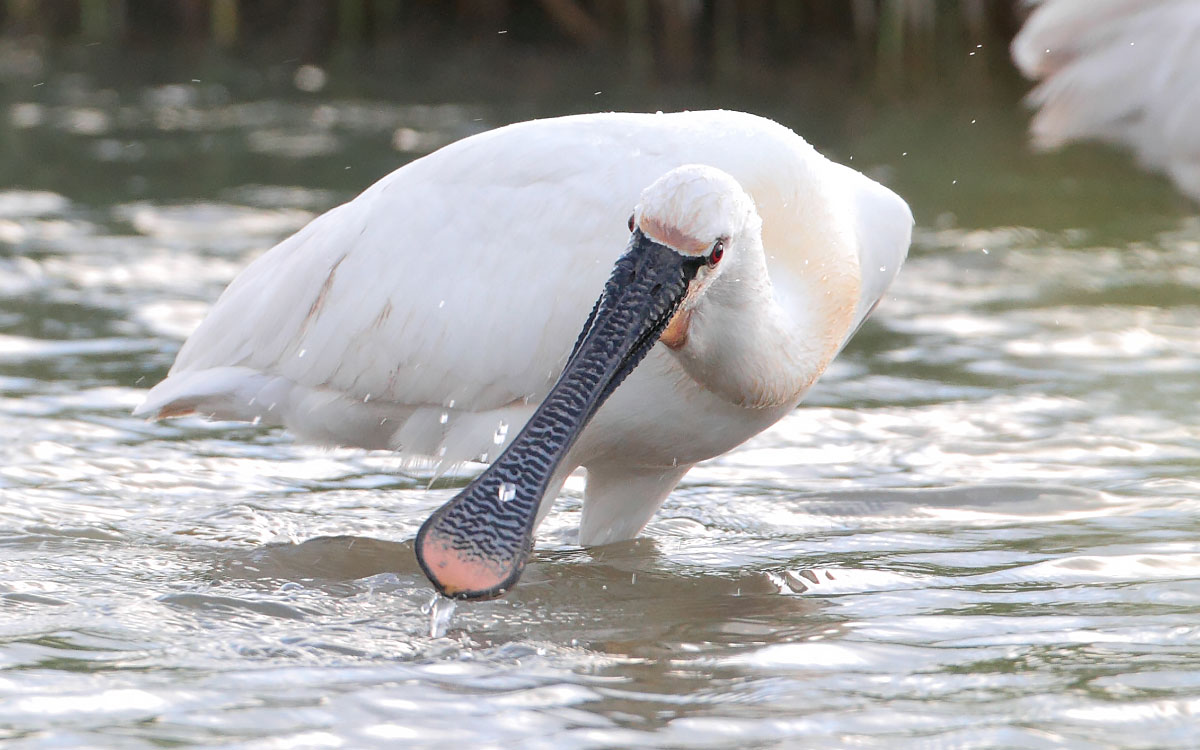
The unusual spatulate bill is the result of a series of adaptations that allow spoonbills to feed efficiently (Jim Almond).
Even the legs are adaptively refined by being laterally compressed to enable them to pass through water with little resistance, while the birds have flat webbed feet for maximum stability on muddy substrates. The proportionate medium-length legs control the depths of water in which spoonbills can forage, completing their adaptation to the shallower water margins of lakes, large rivers and estuaries.
Family affair
The spoonbills are now known to fit genetically into the Pelecaniformes – which also includes herons, pelicans, Shoebill and Hamerkop – and, more precisely, into the ibis family, Threskiornithidae. Their DNA resolves into their own subfamily-level clade (that is, the complete descendants of one common ancestor), the Plataleinae, which separated from the Old World ibises around 43 million years ago. There are six accepted spoonbill species, and some of the Old World species are closely related enough to hybridise on occasion; a male Eurasian Spoonbill was seen to interbreed with two female Black-faced Spoonbills in South Korea between 2012 and 2015, producing nine offspring with intermediate features.
Eurasian Spoonbill Platalea leucorodia is widespread across southern Europe. It has three recognised subspecies, of which the isolated Mauritanian subspecies balsaci is genetically distinct and has a fully black bill and almost no yellow on its chest in the breeding season. The nominate form mingles with this taxon in winter without any interbreeding later in the season. An apparently less distinct but smaller subspecies, archeri, breeds in the Red Sea.
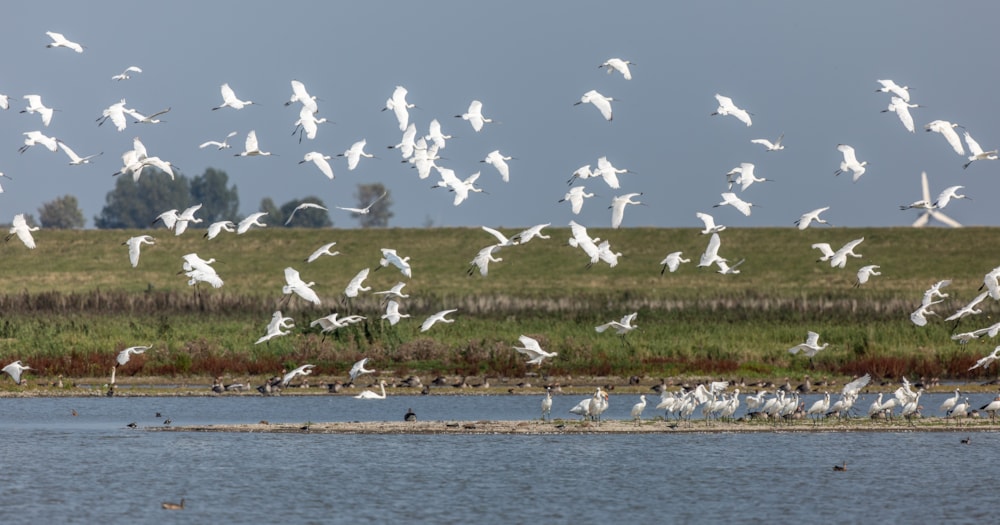
The entire Western Palearctic population of Eurasian Spoonbill numbers between 10,000 and 15,000 (Carsten Sondergaard).
Eurasian Spoonbill is generally migratory. Most of the European population winters in the Mediterranean Basin and northern and western Africa, though a few individuals have wandered to Cape Verde in the west and the Korean peninsula in the east. Small, roughly V-shaped flocks can be seen overhead and at estuaries and larger lakes heading south from July onwards. That said, the species can be observed sparsely in Britain during mid-winter and some movements – particularly post-breeding – are relatively local.
Outside Europe, the species is found across Central Asia to north-eastern China and from India to the Red Sea. Its entire Western Palearctic population numbers no more than 15,000 (probably closer to 10,000) according to the latest IUCN estimate, with the majority based in Spain, The Netherlands, Russia and south-eastern Europe.
Birds begin arriving back at their marshland colonies from late February; these can be in reedbeds, low bushes or trees, but always with easy access to an extensive wetland. At many of the tightly packed colonies, interconnecting paths of broken branches and stems develop between the nests as birds steal prime twigs from each others' nests.
Territorial defence
Eurasian Spoonbill's monogamous relationships form at the (often natal) colony. It is not currently known whether these pairings are resumed the following year. Males arrive first to set up a small nesting territory, defending it with intimidation by wing flapping, neck stretching and bill snapping and aggressive chasing. The mating display includes graceful bowing and presentation of nest material and a mutual touching of bills (sometimes involving clattering and snapping) reminiscent of kissing, as well as raising of the crest and exposure of the orange throat.
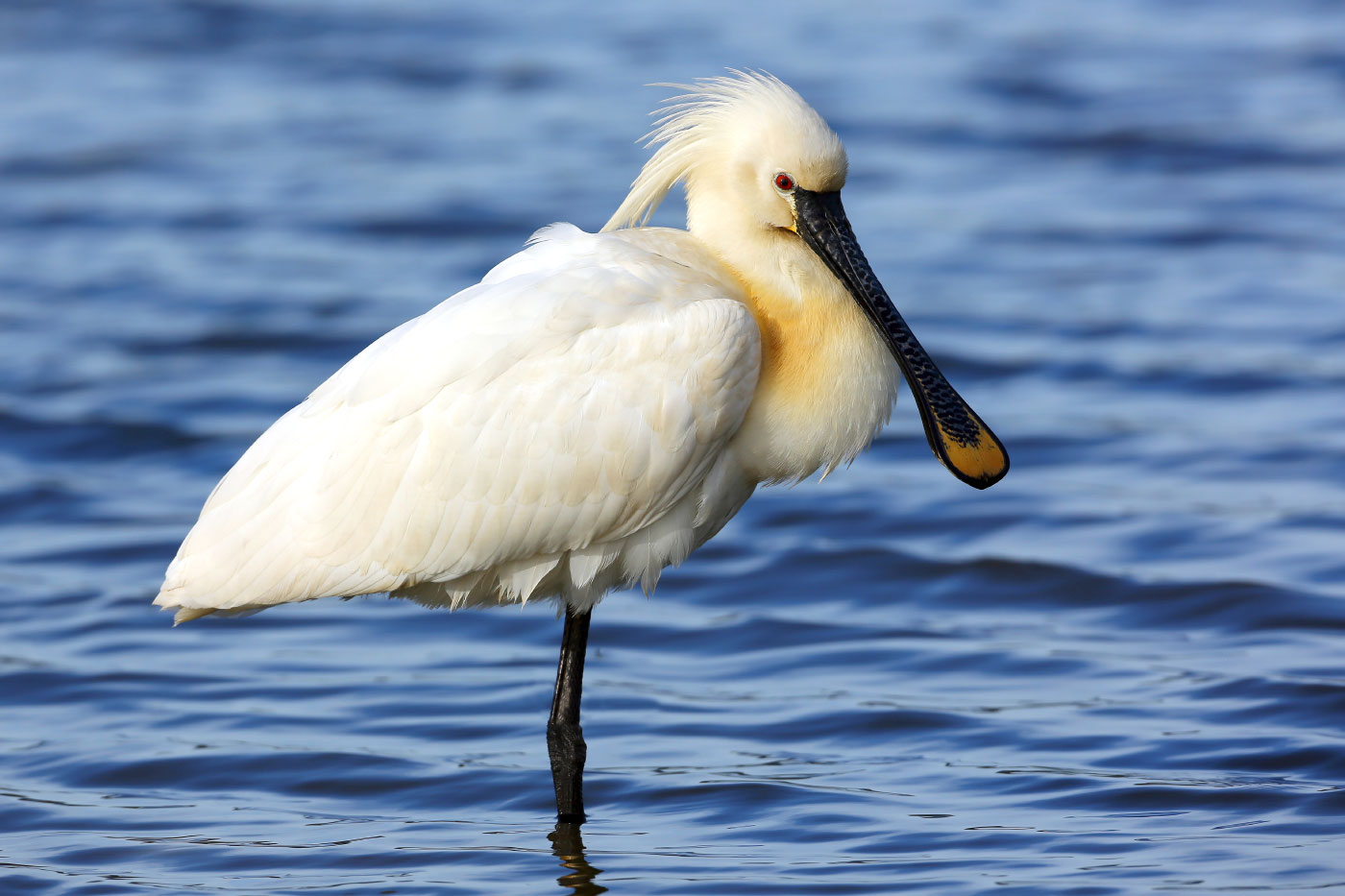
Although largely white, breeding adults have egret-like head plumes, a bright orange bib of bare skin and a yellow 'mayoral chain' round their necks (Aurélien Audevard).
Despite this apparent mate loyalty, both sexes 'cheat' on each other and 19 per cent of copulations are outside the pair, particularly those of males straying after egg laying begins. Females tend to indulge in extra-pair copulation while the males are collecting nesting material after mating themselves – harsh, but also perhaps ensuring brutal fairness in sperm competition within the female's reproduction system.
The species' behaviour seems to have evolved to accommodate such extracurricular activity. Mating occurs mostly at the nest, and both males and females forage for their partner, spending a roughly equal time attending the nest, allowing the space and time for mating with other birds while the partner's back is turned.
The rustic twig and reed platform nest is usually sited no more than 5 m above the ground. The female lays a single brood of about four off-white eggs which are sparsely decorated with reddish-brown Pollock-esque splashes.
The fairly undeveloped and dependent chicks hatch after 21-25 days. Covered in thin tufts of silky-tipped white down, they do not have the extraordinary beak of the adult, but rather a crumpled-looking, soft, pale pink bill, not dissimilar to its ibis relatives at the same age. After four weeks of being fed by both parents, the fledglings leave the nest and are flying freely after seven weeks; however, the juveniles won't be ready to breed until they are three or four years old.
Gatherings of Eurasian Spoonbill in Britain at the end of summer tend to be a mix of juveniles and adults and the species takes its time moving on. Now is the time to observe spoonbills with relative ease as birds can pitch up at almost any wetland south of the Highlands, particularly at well-known reserves in the south. If you see a small flock, give them plenty of time to entertain with their idiosyncratic feeding style and wish these not-so-new immigrants good luck in their continuing lives as British citizens.
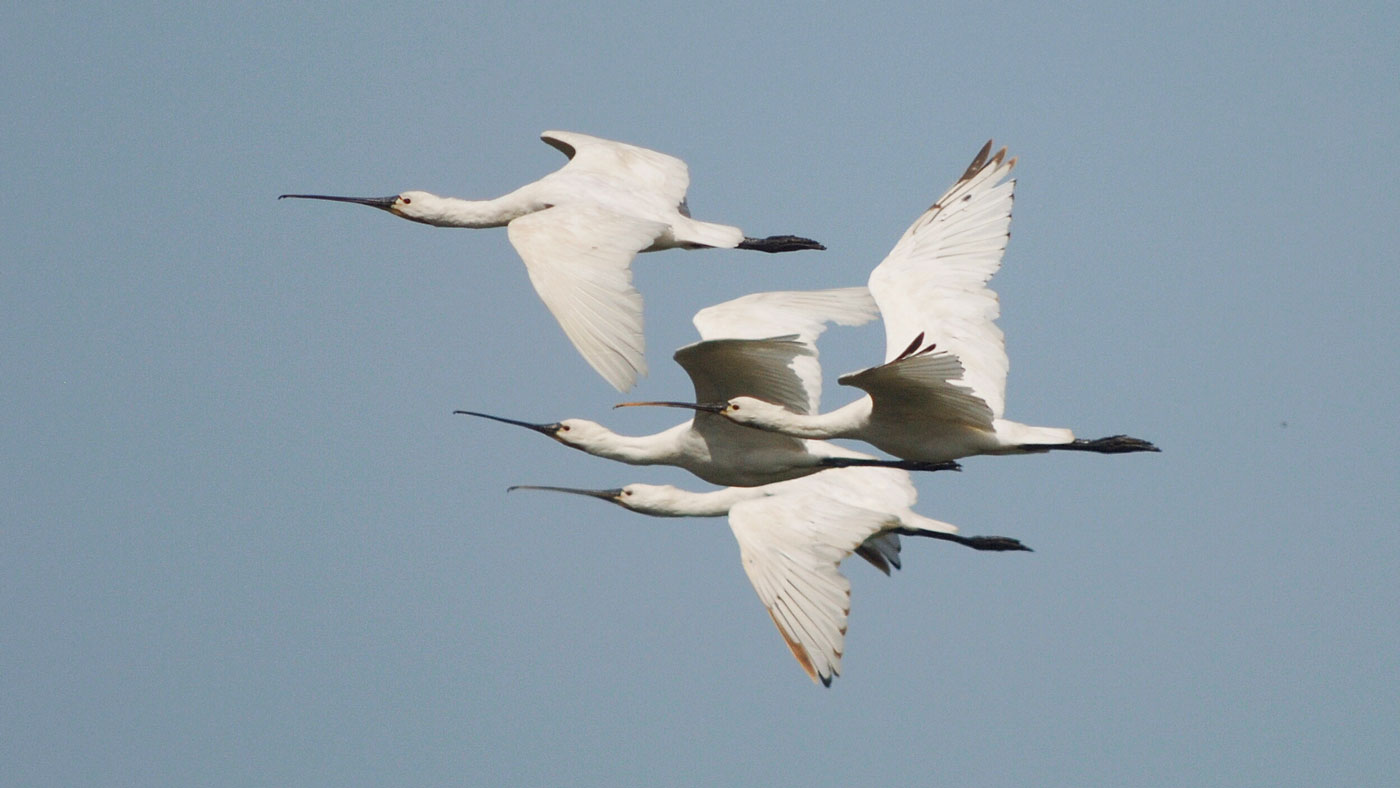
July is a good time to see formations of Eurasian Spoonbill as the species starts to head south for the winter (Julian Bhalerao).
References
Aguliera, E. 1989. Sperm Competition and Copulation Intervals of the White Spoonbill (Platalea leucorodia, Aves, Threskiornithidae). Ethology 82: 230-237.
Aguilera, E, and Alvarez, F. 1989. Copulations and Mate Guarding of the Spoonbill (Platalea leucorodia). Behaviour 110: 1-22.
Arizaga, J, Garaita, R, González, H, and Laso, M. 2016. Stopover use by the Eurasian Spoonbill (Platalea leucorodia) of wetlands on the Basque coast (northern Iberia). Revista Catalana d’Ornitologia 32: 1-10.
Bloomfield, A. 2018. The Spoonbill – a Holkham success story www.holkham.co.uk/blog/post/the-spoonbill-a-holkham-success-story.
Harrison, C. 1975. A Field Guide to the Nests, Eggs and Nestlings of British and European Birds. Collins, London.
Kemper, J H. 1995. Role of the Three-spined Stickleback Gasterosteus aculeatus L. in the food ecology of the Spoonbill Platalea leucorodia. Behaviour 132: 1285-1299.
Kwon, I-K, Lee, K-S, Lee, J-Y, Park, J-H, and Yoo, J-C. 2017. Hybridization between the Black-Faced Spoonbill (Platalea minor) and Eurasian Spoonbill (Platalea leucorodia) in South Korea. Waterbirds 40: 77-81.
Piersma, T, van der Velde, M, El-Hacen, M, Lok, T, and Overdijk, O. 2012. Molecular Verification of the Subspecies Status of the Mauritanian Spoonbill Platalea Leucorodia Balsaci. Ardea 100: 1231-136.
Ramirez, J L, Miyaki, C Y, and Del Lama, S N. 2013. Molecular Phylogeny of Threskiornithidae (Aves: Pelecaniformes) based on nuclear and mitochondrial DNA. Genetics and Molecular Research 12: 2740-2750.
Rare Birds Breeding Panel www.rbbp.org.uk.
Smart, M, Azafzaf, H, and Diensi, H. 2007. The 'Eurasian' Spoonbill (Platalea leucorodia) in Africa. Ostrich 78: 495-500.
Snow, D W, and Perrins, C M. 1998. The Birds of the Western Palearctic (Concise edition) – Volume 1: non-passerines. Oxford University Press, Oxford.
Swennen, C, and Yu, Y-t. 2004. Note of feeding structures of the Black-faced Spoonbill Platalea minor. Ornithological Science 3: 119-124.
Swennen, C, and Yu, Y-t. 2008. Bill sweeping in spoonbills Platalea: no evidence for an effective suction force at the tip. Journal of Avian Biology 39: 3-6.
van Dijk, K, and Bakker, T. 1998. Dutch Spoonbills Platalea leucorodia and a Finnish Tumstone Arenaria interpres on tropical islands: counts of shorebirds in the Cape Verdes in March 1996. Wader Study Group Bulletin 86: 40-43.



